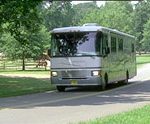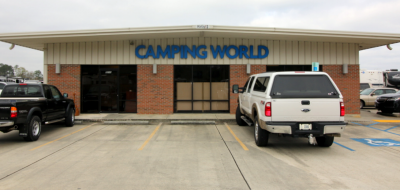Dear RV Doc,
My emergency start switch is not working on my Fleetwood motorhome. Can you provide trouble shooting steps? – Ron Berube, (Endicott, NY)
Answer:
 Ron, in many cases, the emergency start switch on a motorhome is nothing more than a momentary dash switch wired to a simple solenoid. On that solenoid you’ll find two large lugs. Each battery system on the motorhome is connected directly to these with large battery cable. The auxiliary battery positive cable connects to one side; the engine battery positive connects to the other.
Ron, in many cases, the emergency start switch on a motorhome is nothing more than a momentary dash switch wired to a simple solenoid. On that solenoid you’ll find two large lugs. Each battery system on the motorhome is connected directly to these with large battery cable. The auxiliary battery positive cable connects to one side; the engine battery positive connects to the other.
The solenoid will also have one or two smaller terminals. If yours has one small terminal, this terminal is wired to the dash switch and the casing of the solenoid must be grounded to the frame of the motorhome by using one of the two mounting bracket holes. If yours has two small terminals, one is ground, the other goes to the dash switch. With DC, it really doesn’t matter which of the two smaller terminals is which. When activated, the solenoid closes and sends auxiliary battery voltage through the solenoid to the engine battery cable, thereby connecting both battery systems into one big battery and hopefully providing enough voltage to crank the engine.
To bench test an emergency start solenoid you’ll need a VOM and a battery source. Connect the VOM leads to the two large lugs with the meter set to the Ohm’s scale or the continuity scale. The meter should show infinity. Next, apply positive 12-volts DC to one of the smaller terminals on the solenoid and negative 12-volts (ground) to the other. If the solenoid only has a single small terminal, attach the ground wire of the 12-volt source to the mounting bracket. When voltage is applied you should hear an audible click as the internal magnet closes the contacts. Also, the reading should indicate “0” on the meter.
The 0-ohms reading is important; you may hear a click, but if you do not have continuity through the contacts, the solenoid is still faulty. If no reading is indicated the solenoid has an “open.” If you read 0-ohms with no voltage applied, the solenoid is “shorted.” A short may also exist between any battery terminal and the casing itself. In either case the solenoid should be replaced. If your coach is equipped with a larger, heavy-duty solenoid, the testing procedures are the same.
(Please feel free to comment, however, please also note that due to the volume of communications I receive from multiple channels I cannot guarantee a personal response in every instance. However, questions of an overall general interest may be considered and published in an upcoming RV Doctor column.)






Ed House
The Seneca Solenoid location is in battery compartment on left side
Ron and Carolyn Palmer
We have a 2007 Seneca, Jayco 37′ motorhome where the electric steps operate only with the motor running. The manual that comes with the home said that a constant 12-volt power to the electric step is supplied through a 20-amp circuit breaker located inside the battery box near the auxiliary start solenoid but we do not know where the auxiliary start solenoid is located. Do you know?
Paul Thicke
I have a 2003 Class C Itasca and had trouble with the aux start from day one. I got a wiring diagram from the factory and everything traced out OK according to the numbers on the wiring diagram. I figured out that two wires on the aux switch needed to be swapped with each other and then the circuit worked perfectly. This leads me to believe that the wiring diagram is labeled wrong and the switch was wired backwards from the factory.